The Economics and Statistics Division maintains archives of previous publications for accountability purposes, but makes no updates to keep these documents current with the latest data revisions from Statistics Canada. As a result, information in older documents may not be accurate. Please exercise caution when referring to older documents. For the latest information and historical data, please contact the individual listed to the right.
<--- Return to Archive
For additional information relating to this article, please contact:
April 29, 2021PROVINCIAL AND TERRITORIAL TOURISM SATELLITE ACCOUNT, 2017 Statistics Canada has updated the Provincial and Territorial Satellite Account, a measure of the size of provincial tourism as measured by expenditures, GDP and employment.
The Provincial and Territorial Tourism Satellite Account contains some important definitions. "Tourism industries" are industries which would cease to exist or would exist at significantly reduced levels of activity in the absence of tourism (e.g. air transportation, accommodation). "Tourism products" are those for which a significant part of their total demand comes from tourists. Tourism expenditures also include spending by tourists on other products that are not considered to be tourism products.
In Nova Scotia's latest Tourism Satellite Accounts for 2017, there was $2.4316 billion in tourism expenditures in the province. Tourism products accounted for $1.9625 billion while other products purchased by tourists amounted to $469.1 million.
Nova Scotia residents spending within the province were the largest part of tourism expenditures. Domestic tourism expenditures were $1,176.8 billion in 2017: $932.3 million on tourism products along with $244.5 million on other products.
Visitors to Nova Scotia from other provinces spent $634.6 million in 2017: $534.3 million in tourism products and $100.3 million in other products.
International visitors to Nova Scotia made $620.1 million in tourism expenditures in 2017: $495.6 million in tourism products and $124.5 million in other products.
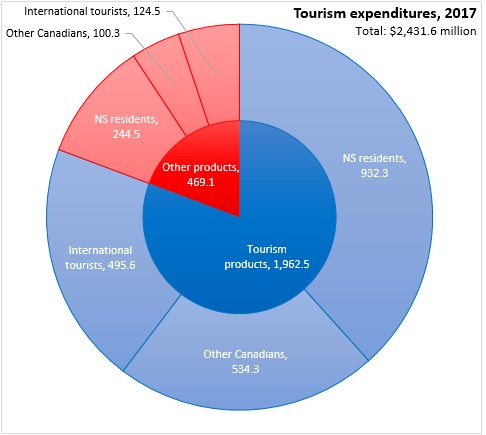
Tourism products can be broken down into four main categories: transportation, accommodations, food and beverage services and other tourism products. The largest parts of transportation expenditures were air travel as well as fuel, vehicle repair/parts and vehicle rentals. Hotels made up the largest part of accommodation expenditures while restaurants make up the bulk of food and beverage service expenditures. Among tourism-related "other products", groceries and alcohol purchased from liquor stores were the largest individual items.
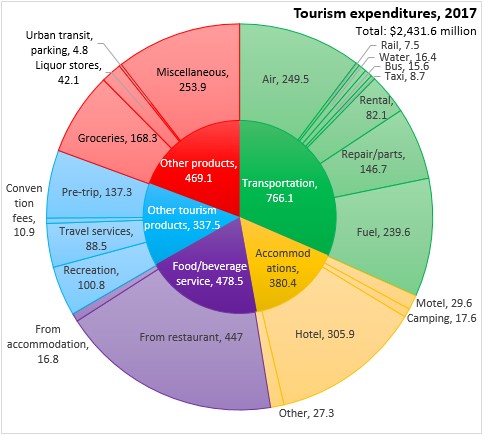
Tourism expenditures of $2,431.6 million generated Gross Domestic Product (GDP) of $936.2 million, which was 2.4% of Nova Scotia's total GDP in 2017. Across Canada, tourism GDP accounted for an average of 2.1% of GDP. Tourism share of GDP was highest in Prince Edward Island and British Columbia (followed by Nova Scotia). The lowest share of tourism in GDP was in Saskatchewan.
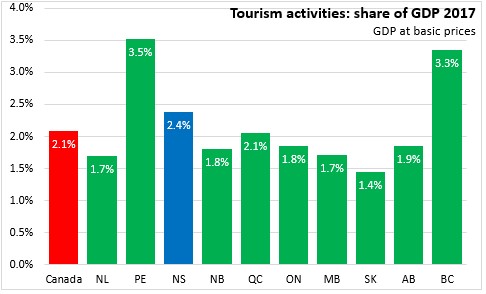
Tourism accounted for 19,300 jobs in 2017, which was 4.2% of total employment. This employment figure includes both full time and part time employment. Nationally, tourism accounted for 3.6% of employment. As with GDP, tourism had the highest portion employment in Prince Edward Island and British Columbia (followed by Nova Scotia). Tourism as a share of employment was lowest in Manitoba.

Tourism jobs were paid $594.1 million in labour income, which was 2.6% of total labour income (third highest after Prince Edward Island anad British Columbia). Tourism generated 2.3% of national labour income.
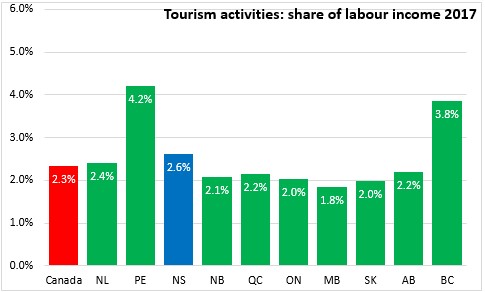
Part time and lower wage employment is more common in tourism industries than in the rest of the economy. Average labour income per tourism job was $32,500 in Nova Scotia, about 51% of the provincial average labour income per job.
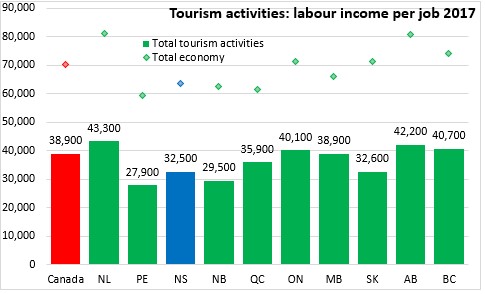
Domestic Demand (travel by residents from within a province) accounted for just under half of tourism product spending (48.4%), with the balance made up between interprovincial exports (visitors from another province in Canada: 26.1%) and international exports (visitors from another country: 25.5%). The domestic share of tourism expenditures was highest in Saskatchewan and Quebec. The lowest domestic share of tourism expenditure was in Prince Edward Island. The interprovincial shares of tourism expenditures were highest in Atlantic Canada and lowest in Quebec and Ontario. International share of tourism expenditure was highest in British Columbia and Prince Edward Island. The lowest shares of international expenditures in tourism were in Newfoundland and Labrador and Saskatchewan.
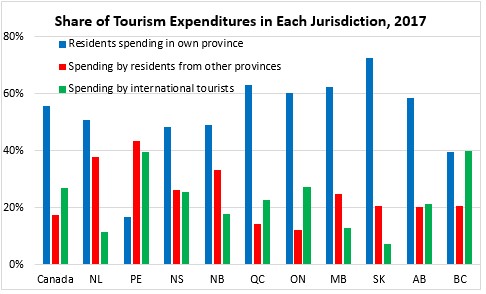
Looking at tourism expenditures by residents of each province, 43.9% of Nova Scotian resident tourism expenditures were made within the province. A further 28.6% of expenditures were made by Nova Scotians in other provinces while the remaining 27.5% of Nova Scotia resident tourism expenditures were made in international destinations.
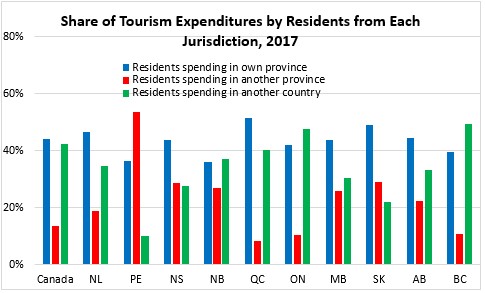
Interprovincial tourism expenditures made in Nova Scotia were $634.6 million while Nova Scotia residents made $764.6 million in tourism expenditures in other provinces. Nova Scotia had positive net exports of tourism with Ontario, British Columbia, Manitoba and Saskatchewan. Quebec was the second largest destination for Nova Scotia resident tourism expenditures across Canada, but it was the third smallest source of interprovincial tourism expenditures in Nova Scotia.

Source: Statistics Canada. Table 24-10-0004-01 Provincial and territorial tourism supply and expenditure (x 1,000,000); Table 24-10-0042-01 Provincial and territorial gross domestic product (GDP) and employment generated by tourism and related measures (x 1,000,000); Table 24-10-0044-01 Interprovincial tourism expenditures (x 1,000,000)
<--- Return to Archive